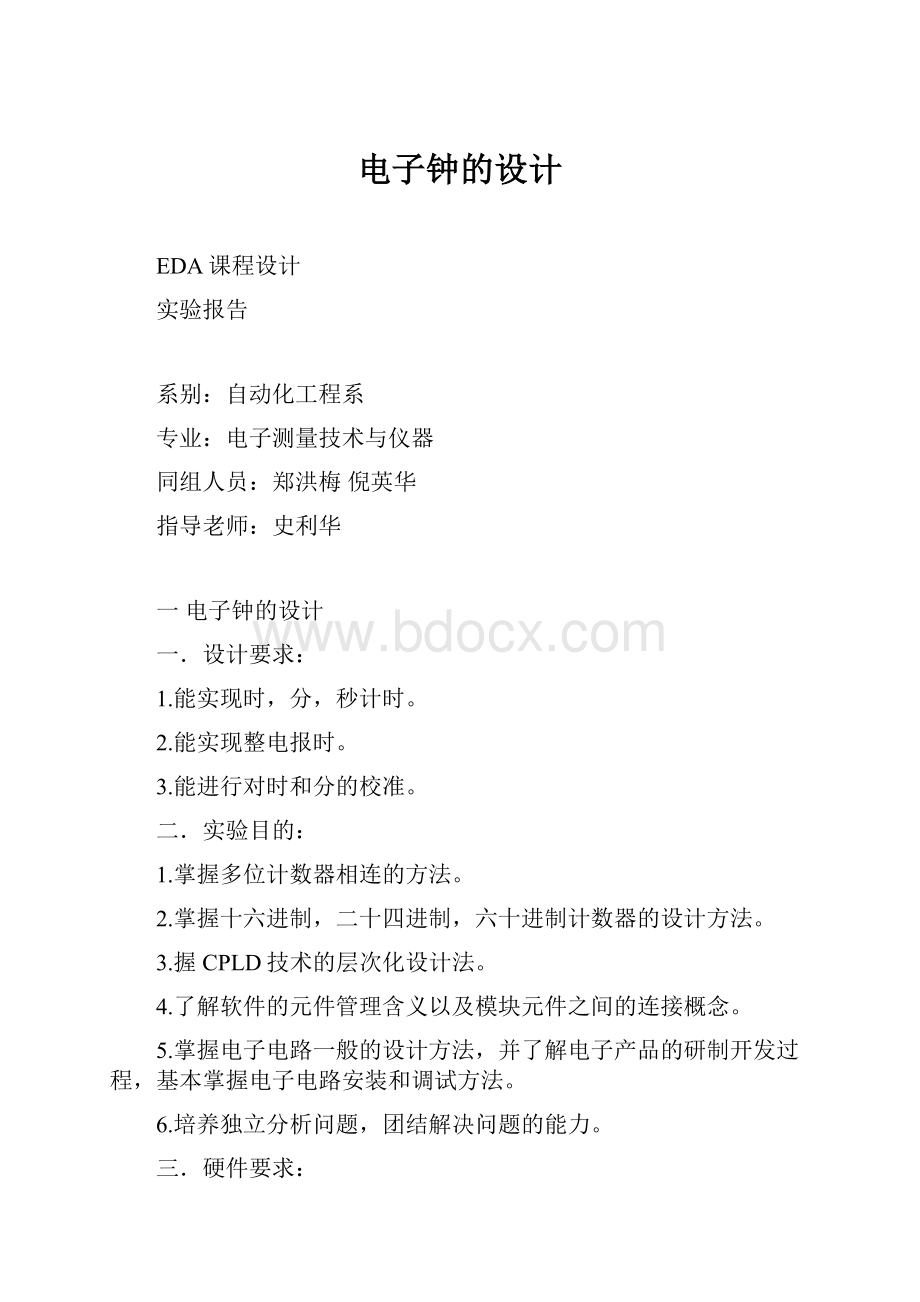电子钟的设计.docx
《电子钟的设计.docx》由会员分享,可在线阅读,更多相关《电子钟的设计.docx(26页珍藏版)》请在冰豆网上搜索。

电子钟的设计
EDA课程设计
实验报告
系别:
自动化工程系
专业:
电子测量技术与仪器
同组人员:
郑洪梅倪英华
指导老师:
史利华
一电子钟的设计
一.设计要求:
1.能实现时,分,秒计时。
2.能实现整电报时。
3.能进行对时和分的校准。
二.实验目的:
1.掌握多位计数器相连的方法。
2.掌握十六进制,二十四进制,六十进制计数器的设计方法。
3.握CPLD技术的层次化设计法。
4.了解软件的元件管理含义以及模块元件之间的连接概念。
5.掌握电子电路一般的设计方法,并了解电子产品的研制开发过程,基本掌握电子电路安装和调试方法。
6.培养独立分析问题,团结解决问题的能力。
三.硬件要求:
1.8位8段扫描共阴极数码显示管。
2.三个按键开关(清零,校时,校分)。
四.设计原理
1.数字钟的计时周期为24小时,显示满刻度为23时59分59秒,另外具备校时功能和报时功能。
因此,一个基本的数字钟主要由“时”“分”“秒”计数器校时电路组成。
将标准信号送入“秒计数器”,“秒计数器”采用60进制计数器,每累加60秒发送一个“分脉冲”信号,该信号将被送到“时计数器”,“时计数器”采用24进制计数器,可实现对一天24小时的累计。
译码显示电路将“时”“分”“秒”计数器的输出状态六段显示译码器译码。
通过六位LED七段显示器显示出来
2.校时电路是用来对“时”“分”显示数字进行校时调整的。
五.电子时钟模块设计
1.分频模块FENPIN设计
模块FENPIN原理图如下:
图3FENPIN原理图
FENPIN源程序
libraryieee;
useieee.std_logic_1164.all;
useieee.std_logic_unsigned.all;
entityFENPis
port(clk1:
instd_logic;
clk:
outstd_logic);
end;
architectureoneofFENPis
signala:
std_logic_vector(8downto0);
signalb,c:
std_logic;
begin
process(clk1)
begin
ifclk1'eventandclk1='1'then
ifa="100000000"then
b<='1';
a<="000000000";
else
a<=a+1;
b<='0';
endif;
endif;
endprocess;
clk<=b;
end;
仿真波形如下:
图4FENPIN波形图
2.模块MIAO1设计
模块MIAO1原理图如下,CLK和RESET控制DAOUT,SETIME和CLK控制ENMIN
图5SECOND的原理图
MIAO1的源程序如下
libraryieee;
useieee.std_logic_1164.all;
useieee.std_logic_unsigned.all;
entitymiao1is
port(clk,reset,setmin:
instd_logic;
daout:
outstd_logic_vector(6downto0);
enmin:
bufferstd_logic);
end;
architecturetwoofmiao1is
signald:
std_logic_vector(6downto0);
signalenmin1,enmin2:
std_logic;
begin
process(clk,reset,setmin)
begin
ifreset='1'
thend<="0000000";
elsif(clk'eventandclk='1')then
ifd<16#60#then
ifd="1011001"then
d<="0000000";enmin1<='1';
elsed<=d+1;enmin1<='0';
ifd(3downto0)="1001"thend<=d+7;
endif;endif;
endif;endif;endprocess;
daout<=d;
enmin<=(enmin1orenmin2);
enmin2<=(setminandclk);
end;
波形仿真图如下
图1-4MIAO1的波形仿真
3.模块FENZ设计
模块FENZ原理图如下,CLK和RESET控制DAOUT,SEHOUR控制ENHOUR
图6fen图
FENZ的源程序如下
libraryieee;
useieee.std_logic_1164.all;
useieee.std_logic_unsigned.all;
entityfenis
port(reset,clk,sethour,clk1:
instd_logic;
daout:
outstd_logic_vector(6downto0);
enhour:
bufferstd_logic);
end;
architecturetwooffenis
signald:
std_logic_vector(6downto0);
signalenhour1,enhour2:
std_logic;
begin
process(clk,clk1,reset,sethour)
begin
ifreset='1'
thend<="0000000";
elsif(clk'eventandclk='1')then
ifd<16#60#then
ifd="1011001"then
d<="0000000";enhour1<='1';
elsed<=d+1;enhour1<='0';
ifd(3downto0)="1001"thend<=d+7;
endif;endif;
endif;endif;endprocess;
daout<=d;
enhour<=(enhour1orenhour2);
enhour2<=(sethourandclk1);
end;
波形仿真图如下
图7FENZ的波形仿真
4.模块HOUR设计
模块HOUR原理图如下,CLK和RESET控制DAOUT。
图8HOUR的原理图
HOUR的源程序如下
libraryieee;
useieee.std_logic_1164.all;
useieee.std_logic_unsigned.all;
entityhouris
port(reset,clk:
instd_logic;
daout:
outstd_logic_vector(5downto0));
end;
architecturetwoofhouris
signald:
std_logic_vector(5downto0);
begin
process(clk,reset)
begin
ifreset='1'
thend<="000000";
elsif(clk'eventandclk='1')then
ifd<16#60#then
ifd="100011"then
d<="000000";
elsed<=d+1;ifd(3downto0)="1001"thend<=d+7;endif;endif;
endif;endif;endprocess;
daout<=d;
end;
波形仿真图如下
图9HOUR的波形仿真
5.模块XIANS设计
模块XIANS原理图如下,当SEL取不同值时DAOUT分别选择输出SEC.MIN.HOUR
图10SELTIME的原理图
SELTIME的源程序
libraryieee;
useieee.std_logic_1164.all;
useieee.std_logic_unsigned.all;
entityseltimeis
port(clk2,reset:
instd_logic;
hour,sec,min:
instd_logic_vector(6downto0);
daout:
outstd_logic_vector(3downto0);
sel:
outstd_logic_vector(2downto0));
end;
architecturebhvofseltimeis
signalq1:
std_logic_vector(2downto0);
begin
process(clk2,reset)
variabledaa:
std_logic_vector(3downto0);
begin
ifreset='1'thendaout<="0000";sel<="000";
elsifclk2'eventandclk2='1'then
q1<=q1+1;
caseq1is
when"101"=>daa:
=sec(3downto0);
when"100"=>daa:
='0'&sec(6downto4);
when"011"=>daa:
=min(3downto0);
when"010"=>daa:
='0'&min(6downto4);
when"001"=>daa:
=hour(3downto0);
when"000"=>daa:
='0'&hour(6downto4);
whenothers=>daa:
="0000";
endcase;
sel<=q1;
daout<=daa;
endif;
endprocess;
end;
仿真波形如下
图11XIANS的波形仿真
6.模块QIDUAN设计
QIDUAN图如下通过判断Q有4位输入数字组成16种状态确定输出Y点亮的什么数字,通过SEL选择输出Y的值。
图12.QIDUAN的原理图
LED源程序如下:
libraryieee;
useieee.std_logic_1164.all;
useieee.std_logic_unsigned.all;
entityledis
port(q:
instd_logic_vector(3downto0);
sel:
instd_logic_vector(2downto0);
y:
outstd_logic_vector(7downto0));
endled;
architecturertlofledis
signalc:
std_logic_vector(7downto0);
begin
process(q,sel)
begin
caseqis
when"0000"=>c(6downto0)<="0111111";
when"0001"=>c(6downto0)<="0000110";
when"0010"=>c(6downto0)<="1011011";
when"0011"=>c(7downto0)<="1001111";
when"0100"=>c(6downto0)<="1100110";
when"0101"=>c(6downto0)<="1101101";
when"0110"=>c(6downto0)<="1111101";
when"0111"=>c(7downto0)<="0000111";
when"1000"=>c(6downto0)<="1111111";
when"1001"=>c(6downto0)<="1101111";
when"1010"=>c(6downto0)<="1110111";
when"1011"=>c(7downto0)<="1111100";
when"1100"=>c(6downto0)<="0111001";
when"1101"=>c(6downto0)<="1011110";
when"1110"=>c(6downto0)<="1111001";
whenothers=>c(6downto0)<="0000000";
endcase;
if(sel="001"orsel="011"orsel="101")then
c(7)<='1';
elsec(7)<='0';
endif;
y<=c;
endprocess;
endrtl;
灯管连线:
仿真波形如下:
图13QIDUAN的波形图
7.模块BAOS设计
LAMP原理图如下,当DAIN为0的时候SPEAK发声,在这段发声时间内LAMP的三个灯相继点亮。
图14LAMP原理图
LAMP源程序如下:
libraryieee;
useieee.std_logic_1164.all;
useieee.std_logic_unsigned.all;
entitylampis
port(clk:
instd_logic;
dain:
instd_logic_vector(6downto0);
speak:
outstd_logic;
lamp:
outstd_logic_vector(2downto0));
end;
architecturebehavoflampis
begin
process(clk)
variableb:
std_logic_vector(1downto0);
variableh:
std_logic;
variablelam:
std_logic_vector(2downto0);
begin
ifdain="0000000"thenh:
='1';
elseh:
='0';
endif;
ifclk'eventandclk='1'then
b:
=b+1;
casebis
when"00"=>lam:
="000";
when"01"=>lam:
="001";
when"10"=>lam:
="010";
when"11"=>lam:
="100";
whenothers=>lam:
="000";
endcase;
endif;
ifh='1'then
lamp<=lam;
elselamp<="000";
endif;
speak<=h;
endprocess;
end;
仿真波形如下:
图15BAOS波形图
顶层原理图如下:
图1顶层文件原理图
时序仿真:
程序仿真主要由计数器完成,在时钟脉冲作用下,完成始终功能,由时序图可以看出每个时钟上升沿到来时加一,当接受到REST信号,即REST为高电平,所有计数为零,并重新计数,SETMIN和SETHOUR可以完成调节时钟功能,都是高电平调节,每来一个脉冲,相应的时或分加1。
图2时序仿真
引脚锁定
Clk=83,lamp0=51,lamp1=50,lamp2=49,led7s0=81,led7s1=80,led7s2=79,led7s3=77,
led7s4=76,led7s5=75,led7s6=74,led7s7=73;res=45,sel0=70,sel1=69,sel2=68;
sethour=41,setmin=44;
实验总结:
通过本次实验我们了解到电子时钟的设计原理,让我们更加了解到这些生活中的东西怎么设计出来的,并且学会找出错误,改正错误。
对时、分、秒的设计了解到很多知道,通过本次学习对我们以后有了很大的帮助。
二交通灯设计
设计说明:
现代,在城市的交通繁忙的交叉路口,行人比较多的路口,或学校附近都设有许多的红绿交通灯。
它指示着行人、车辆有序的通行。
其中,红灯停,绿灯行,黄灯表警示。
在灯的旁边还有数字晶体显示器,用于提示行人、司机三种颜色的灯即将跳转所剩的时间,让其做好应有的准备。
一.设计要求:
1.在十字路口的方向上各设一组红绿黄灯,显示顺序为:
其中一个方向是绿灯、黄灯、红灯,另外一个方向是红灯、绿灯、黄灯。
2.设置4个数码管,以倒计时的方式显示允许通过或禁止的时间,其中绿灯、黄灯、红灯的持续时间分别是30秒、5秒、35秒。
二.设计原理图
状态转换图
三、各模块设计
1、模块CNT8设计
模块FENPIN如下图,该模块的功能是将时间256分频,得到占空比为1:
256的方波。
图1-4CNT8顶层图
分频器FP程序:
libraryieee;
useieee.std_logic_1164.all;
useieee.std_logic_unsigned.all;
entityfpis
port(clk:
instd_logic;
sel:
outstd_logic_vector(2downto0);
d:
outstd_logic);
end;
architecturebhvoffpis
signalclk2:
std_logic;
signalq:
std_logic_vector(2downto0);
begin
process(clk,clk2)
variablecount:
std_logic_vector(7downto0);
begin
ifclk'eventandclk='1'then
ifcount="10000000"thenclk2<=not(clk2);count:
="00000000";
elsecount:
=count+1;
endif;
endif;
endprocess;
d<=clk2;
process(clk)
begin
ifclk'eventandclk='1'thenq<=q+1;
endif;
endprocess;
sel<=q;
endbhv;
波形仿真如下:
图1-5CNT8波形仿真图
2、模块JTD设计
如图1-2,该模块为整个程序的核心,它实现东西和南北方向的三种交通灯颜色的交替点亮、时间的倒计时。
图1-6JTD顶层图
JTD的源程序
libraryieee;
useieee.std_logic_1164.all;
useieee.std_logic_unsigned.all;
entitydengis
port(clk,clr:
instd_logic;
dx,nb:
outstd_logic_vector(2downto0);
shi1,ge1:
outstd_logic_vector(3downto0));
end;
architectureadofdengis
signalshi,ge:
std_logic_vector(3downto0);
typefsm_stis(s1,s0,s2,s3);
signalstate:
fsm_st;
begin
process(clk,clr)
begin
ifclr='1'thenstate<=s0;ge<="0000";shi<="0011";
elsifclk'eventandclk='1'then
casestateis
whens0=>dx<="100";nb<="001";
ifge="0000"thenifshi="0000"thenstate<=s1;
ge<="0101";shi<="0000";
elseshi<=shi-1;
ge<="1001";
endif;
elsege<=ge-1;
endif;
whens1=>dx<="100";nb<="010";
ifge="0000"thenifshi="0000"thenstate<=s2;
ge<="0000";shi<="0011";
elseshi<=shi-1;
ge<="0000";
endif;
elsege<=ge-1;
endif;
whens2=>dx<="001";nb<="100";
ifge="0000"thenifshi="0000"thenstate<=s3;
ge<="0101";shi<="0000";
elseshi<=shi-1;
ge<="1001";
endif;
elsege<=ge-1;
endif;
whens3=>dx<="010";nb<="100";
ifge="0000"thenifshi="0000"thenstate<=s0;
ge<="0000";shi<="0011";
elseshi<=shi-1;
ge<="0101";
endif;
elsege<=ge-1;
endif;
endcase;
endif;
shi1<=shi;
ge1<=ge;
endprocess;
end;
波形仿真图如下:
图1-7JTD波形仿真图
3、模块MUX设计
顶层图如下,通过SEL的不同状态选择输出不同的值,当SEL=“000”输出“shi”,当SEL=“001”时输出“ge”。
图1-8MUX顶层图
MUX源程序如下:
libraryieee;
useieee.std_logic_1164.all;
entitymux1is
port(ge,shi:
instd_logic_vector(3downto0);
sel:
instd_logic_vector(2downto0);
y:
outstd_logic_vector(3downto0));
end;
architecturegaofmux1is
begin
process(sel)
variabled:
std_logic_vector(3downto0);
begin
caseselis
when"001"=>d:
=ge;
when"000"=>d:
=shi;
whenothers=>d:
="0000";
endcase;
y<=d;
endprocess;
end;
波形仿真图如下:
图1-9波形仿真图
4、模块LED设计
顶层图如下,通过判断Q有4位数字组成16种状态,确定输出Y点亮什么数字。
通过SEL选择输出Y的值。
图1-10LED顶层图
LED源程序如下:
libraryieee;
useieee.std_logic_1164.all;
useieee.std_logic_unsigned.all;
entityledis
port(q:
instd_logic